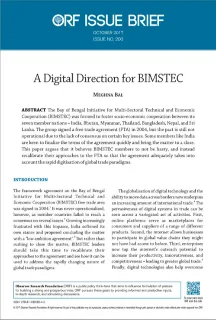The BIMSTEC Technology Working Group will have to take the lead in drafting a set of provisions for BIMSTEC’s digital-centric FTA. While it designs this framework, the group should keep the following principles in mind:[xlviii]
- Functionality[xlix]
A regulatory strategy that employs a functionality-based approach starts by evaluating what regulatory goals to strive for, and how they can be efficiently realised, regardless of externalities such as technologies.[l]
Functional regulation recognises that the inherent differences in different technologies might call for these technologies to be regulated differently.[li] Further, it also recognises that technology is rapidly evolving. An example of a functional policy prescription would be technology neutrality or technology agnosticism.[lii] The latter is deemed to be a better criterion as it lends a broader scope to regulation.[liii]
- Flexibility[liv]
The regulatory framework must promote dynamism and innovation by favouring a flexible, performance-based approach over rigid, prescriptive standards.[lv]
Competition typically enables a dynamic marketplace.[lvi] Thus, when it comes to regulating the commercial digital ecosystem, regulatory agencies should defer decision making to the markets as much as possible.[lvii] If interventions are required, regulators should seek to prescribe standards that can be enforced ex-post as opposed to ex-ante.[lviii]This will allow regulations to keep step with evolving technologies and marketplaces.[lix]
- A bottom-up approach[lx]
Taking a bottom-up approach means applying a consistent set of criteria to assess the market share within online networks and target areas where regulatory issues may arise in the future instead of judging how they came up in the past.[lxi]
A framework based on these principles will allow for greater market and technological neutrality, which are important considerations for cross-border digital commerce.[lxii] It will also facilitate the achievement of regulatory objectives in a cost-effective way.[lxiii] Finally, it will engender a modicum of flexibility which will allow innovation to go on unfettered while meeting larger regulatory objectives.[lxiv]
A concerted effort must be made to ensure that the provisions of the FTA are drafted in a way that meets the interests of member nations. For instance, in the case of IP, special care should be taken to ensure that provisions do not jeopardise a country’s ability to safeguard its traditional knowledge resources. Further, they should be geared towards larger development goals like increasing access to knowledge and medical care. Moreover, the FTA must address intraregional concerns in digital trade by including provisions that allow for the free cross-border movement of data and ensure that individuals and small businesses in all member countries can take advantage of e-commerce platforms and communicate efficiently at low cost, as well as access, move, and store data freely.
An FTA that addresses the digital aspects of commerce could benefit BIMSTEC in several ways. First, it could help fill several gaps in extant domestic regulatory frameworks that could stimulate innovation and growth at the local level. Second, it could allow for a freer and more open internet in the region and promote commerce without borders. Thus, it could help foster greater intra-regional trade. Third, it would insulate member nations from having to follow standards like those set out in the TPP. Given the historical background of how standards have traditionally been espoused, it is inevitable that BIMSTEC countries will be forced to adhere to the TPP norms if they are unable to create a template of their own. It would also give countries which are part of the RCEP agreement, like India and Thailand, considerable leverage in the negotiation process. Fourth, it could be a source of considerable soft-power for BIMSTEC. If member nations were to bring out this FTA before the TPP, it would be the first agreement to take on digital trade and promote electronic commerce. Finally, digital trade could provide the common ground that could help break the current impasse within BIMSTEC free trade negotiations. BIMSTEC members are perfectly placed to agree on digital issues as they are similarly placed in terms of their economic standing and the development of their digital ecosystems.
The process of developing this agreement must be informed by lessons from the past. A historical assessment of the BIMSTEC FTA negotiations reveals that a dynamic of this sort can only work if members’ objectives are aligned closely with one another. IP is one such area where BIMSTEC nations share common ground. As mentioned earlier, most BIMSTEC nations have similar priorities when it comes to IP, such as the preservation of traditional knowledge and ensuring access to medicines. IP could form the basis of an informed framework for engagement, which would also reflect other priorities of BIMSTEC countries in matters of digital trade. This would then leave behind the traditional discord between member nations and ameliorate addressing key policy fields for cooperation. A measured and coordinated approach will thus ensure long-term success for the BIMSTEC grouping and the development of a robust digital economy within the region.
Endnotes
[i]Asit Mishra, India Softens its Stance on Bay of Bengal Free Trade Agreement, Livemint 2016, http://www.livemint.com/Politics/GxcCHglHmc5GelTo5GPLeI/India-softens-stance-on-Bay-of-Bengal-free-trade-agreement.html
[ii]Ibid
[iii]Ibid
[iv]Joshua Paul Meltzer, “A New Digital Trade Agenda,” E15 Expert Group on the Digital Economy (The E15 Initiative, August 2015), http://e15initiative.org/publications/a-new-digital-trade-agenda/.
[v]Ibid
[vi]Ibid
[vii]“Harmonizing Cyber Laws and Regulations: The Experience of the East African Community” (New York and Geneva: United Nations Conference on Trade and Development, 2012), http://unctad.org/en/PublicationsLibrary/dtlstict2012d4_en.pdf.
[viii]“The Trans Pacific Partnership” (USTR, n.d.), https://ustr.gov/sites/default/files/TPP-Overall-US-Benefits-Fact-Sheet.pdf.
[ix] “Harmonizing Cyber Laws and Regulations: The Experience of the East African Community” (New York and Geneva: United Nations Conference on Trade and Development, 2012), http://unctad.org/en/PublicationsLibrary/dtlstict2012d4_en.pdf.
[x]Ibid
[xi]Ibid
[xii]Ibid
[xiii] Ibid
[xiv]“Electronic Transactions Law – The State Peace and Development Council Law No. 5/2004” (2004), http://unpan1.un.org/intradoc/groups/public/documents/un-dpadm/unpan041197.pdf.
[xv]Ibid
[xvi]Ibid
[xvii]Ibid
[xviii]Ibid
[xix] “Harmonizing Cyber Laws and Regulations: The Experience of the East African Community” (New York and Geneva: United Nations Conference on Trade and Development, 2012), http://unctad.org/en/PublicationsLibrary/dtlstict2012d4_en.pdf.
[xx] “Information Technology Act” (2000), http://www.dot.gov.in/sites/default/files/itbill2000_0.pdf.
[xxi]Peter Drahos, “Developing Countries and International Intellectual Property Standard-Setting,” The Journal of World Intellectual Property 5 (2002): 765–789, doi:10.1111/j.1747 1796.2002.tb00181.x.
[xxii]Ibid
[xxiii]Ibid
[xxiv]Ibid
[xxv]Ibid
[xxvi]Ibid
[xxvii] Ibid
[xxviii]Ibid
[xxix]Ibid
[xxx]Ibid
[xxxi]Ibid
[xxxii]Ibid
[xxxiii]Ibid
[xxxiv]Ibid
[xxxv]Ibid
[xxxvi]Ibid
[xxxvii]Ibid
[xxxviii]Ibid
[xxxix] “Mega-Regional Trade Agreements Game-Changers or Costly Distractions for the World Trading System?,” Global Agenda Council on Trade & Foreign Direct Investment (World Economic Forum, July 2014), http://www3.weforum.org/docs/GAC/2014/WEF_GAC_TradeFDI_MegaRegionalTradeAgreements_Report_2014.pdf.
[xl] “The Trans Pacific Partnership” (USTR, n.d.), https://ustr.gov/sites/default/files/TPP-Overall-US-Benefits-Fact-Sheet.pdf.
[xli] Elizabeth Roche, “Why Is Bimstec so Important for India,” Livemint, October 24, 2016, http://www.livemint.com/Politics/4JsOSUC4N81BK0T7zNYecK/Why-is-Bimstec-so-important-for-India.html.
[xlii] Ibid
[xliii]Ibid
[xliv]Ibid
[xlv]Ibid
[xlvi]Ibid
[xlvii] Ibid
[xlviii] “A New Regulatory Framework for the Digital Ecosystem” (London: GSMA, 2016), https://www.gsma.com/publicpolicy/wp-content/uploads/2016/09/GSMA2016_Report_NewRegulatoryFrameworkForTheDigitalEcosystem_English.pdf.
[xlix] Ibid
[l]Ibid
[li]Ibid
[lii]Ibid
[liii]Ibid
[liv]Ibid
[lv]Ibid
[lvi]Ibid
[lvii]Ibid
[lviii]Ibid
[lix]Ibid
[lx]Ibid
[lxi]Ibid
[lxii]Ibid
[lxiii]Ibid
[lxiv]Ibid

 PDF Download
PDF Download



 PREV
PREV


